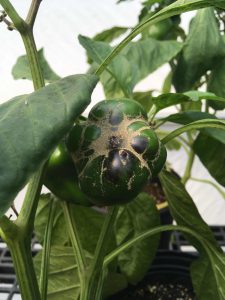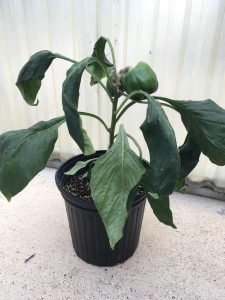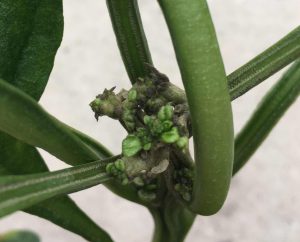Consider a microscopic pest that is a master of hiding and waiting, silently but rapidly building in numbers so that by the time you know what you are dealing with, the damage has already been done. This pest is the broad mite, Polyphagotarsonemus latus, and if it is not identified and managed early, control can be very difficult and damage to your greenhouse plants could be devastating.
Biology
Female mites are about 0.2 mm long and the males are even smaller at 0.11 mm. Broad mites have oval bodies with four pairs of legs, although young broad mites have three pairs of legs. They have short life cycles and produce many eggs (30-76 eggs per mite), so they can reach high numbers quickly.
Damage
The broad mite attacks many greenhouse and ornamental plants. It feeds on leaves and flower buds causing them to become malformed (Figure 1). The mite’s saliva is toxic causing leaves to become twisted and distorted. Another interesting fact is that the broad mite can use other insects as a means of transportation to move from plant to plant, such as whiteflies which are an important greenhouse pest.

Early detection and management of this pest is crucial. Look for downward turning leaves (Figure 2) and damage to terminal buds (Figure 3). Mites can usually be found feeding on the newest leaves and small fruit. Beware of confusing broad mite injury with symptoms of overwatering, nutrient deficiency, heat damage, or diseases. Once you determine that you are dealing with broad mites, you need to apply control quickly and persistently.


Control
Miticides are available to effectively control the pest. Insecticidal soaps and oils can also be applied and, if the pest is detected early enough before numbers are high, can be very effective and less toxic to the environment. There is also biological control by predatory mites that love to eat broad mites.
For more information about broad mites, visit http://entnemdept.ufl.edu/creatures/orn/broad_mite.htm.
 0
0
